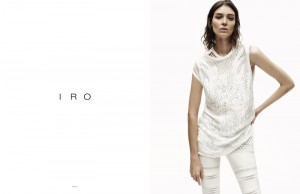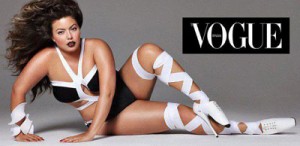May
2
Magazine’s Affect on Society’s View of Beauty
May 2, 2016 | Tagged advertisement affect views, beauty, body image, image, Media | Comments Off on Magazine’s Affect on Society’s View of Beauty

Kati Nescher: Model for clothing brand IRO
Look at this image. What words come to mind?
Thin. Pretty. Cheekbones. Model. Chic.
Anorexic. Unrealistic. Gross.
Some people look at this image and different words come to mind, but on thing is certain. Media is flooded with pictures and advertisements like this one.
This is an advertisement found in a magazine; this image is similar to many ads and photos found in most magazines. While the model is beautiful, it is images like this one that have affected the way society views beauty.
The way that news, especially entertainment news, presents the image of the human body can be unattainable, or even unhealthy for some; however, people still strive to look like models in the magazine. The influence that magazines have on society is strong. The greatest impact is on younger aged females. In fact, anorexia is 12 times more likely to cause death than any other condition among young women ages 15 to 24 (Anorexia, 2016). The National Eating Disorders Association reports that 90 to 95 percent of people who have anorexia are females. “That’s not surprising, given the cultural pressures modern women face and the modern representation of the ideal female body… Artists use sophisticated computer programs to trim away the curves on people who pose for magazine photographs” (Anorexia, 2016).
That is not to say that men do not have similar struggles. Images of male models often consist of slim men with either boyish figures or extremely muscular bodies. Often times the “manly” men are the leading roles or focal point with the slim ones, seen as the boyish type, as supporting roles (Femiano & Nickerson). They are shown wearing tight fitted clothing. In response, men have placed more emphasis on their appearance and physique than in the past, and it is partially due to the over exposure to that appearance of men in the media and magazines. The Center for Media Literacy touched on this very idea. Same Femiano and Mark Nickerson, writers for the site, said:
“Bravery, adventurousness, being able to think rationally, being strong and effective, for example, are all “manly” traits that are usually encouraged. So also are the ability to think independently and take the initiative. Media images supporting these behaviors include the strong, silent Marlboro man and military ads telling young men to “be all you can be.” (Young women, on the other hand, are urged to pursue beauty and sex appeal.)… These narrow masculine standards can lead to discrimination against those who deviate from them. But they can also prevent men themselves from living up to their full potential as human beings.”
With that being said, men tend to fit into societal expectations similarly to women.
This raises a question: what is the magazine’s goal? Is it to influence society, to make a profit, or simply to write juicy fun stories? For some reason I cannot picture the editor of Allure in a publishing meeting saying, “I want everyone to love skinny people and see them as the prettiest.” But even with this unintentional influence, entertainment news sources still have a responsibility to the public. It is unethical to ignore the influence that this form of media has on society.
Recognizing this, some magazines have begun printing advertisements using plus-size models. Take this photo for example.

The Vogue ad, starring a plus size model, is a rarity in the industry. Some similar advertisements, in fact, have received pushback from subscribers, but the goal for these ads is to highlight all forms of beauty. This approach to the societal influence is one to be modeled after. Companies are tackling this ethical dilemma by stepping out of the norm and presenting a plus size model even while receiving criticism for the decision. One issue that has been brought up as a criticism is that companies are “promoting” obesity. While this could be an issue similar to promoting an unhealthy skinny body image, the average woman is a size 12. So, encompassing larger woman targets more women, but it is important to find the middle ground between too small and obese. This is a similar idea to Aristotle’s Golden Mean ethical theory. This refers to the idea of finding the mean between two extremes of a choice. Here, there is the choice to use a model that is unhealthily small or one that falls under the obese category. The Golden Mean would recommend what was previously stated, which is using a model with an average body that represents the average person.
It is important to consider all publics and the affects that advertisements have on societal views and even personal health habits. This new advertisement approach would be a refreshing change to see become more popular and more widely accepted.
Comments
You must be logged in to post a comment.